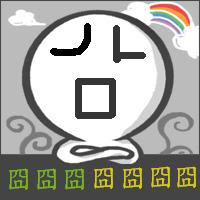主要步驟:
a.開啟Silverlight專案
b.新增SilverLight幾何元件
c.編寫animation程式內容
1、開啟一個新的SilverLight專案後,在主要的 xmal 檔中先找到<UserControl>,並在此tag先加入幾個Silverlight元件,在加入Silverlight元件前,我們要求元件做整齊的排列,所以額外請加入一個Grid來排列每個元件。
2、下述<Grid>使用<Ellipse>元件來從事animaltion的動作,我們會對每個<Ellipse>元件加入一個 'onMouseLeftDown' 的屬性,當此元件被按下時,將會觸發 leftDown( ) 函式,以下為需加入xmal檔內<UserControl>的描述。
<Grid x:Name="LayoutRoot">
<Grid.RowDefinitions>
<RowDefinition Height="80"/>
</Grid.RowDefinitions>
<Grid.ColumnDefinitions>
<ColumnDefinition Width="80"/>
<ColumnDefinition Width="80"/>
<ColumnDefinition Width="80"/>
<ColumnDefinition Width="80"/><!--3-->
<ColumnDefinition Width="80"/>
<ColumnDefinition Width="80"/>
<ColumnDefinition Width="80"/><!--6-->
<ColumnDefinition Width="80"/>
<ColumnDefinition Width="80"/><!--8-->
</Grid.ColumnDefinitions>
<Ellipse x:Name="e0_0" Width="40" Height="40" StrokeThickness="2" Grid.Row="0" Grid.Column="0"
MouseLeftButtonDown="leftDown" >
<Ellipse.Fill>
<LinearGradientBrush EndPoint="0.5,1" StartPoint="0.5,0">
<GradientStop Color="#FFFF7100" Offset="0"/>
<GradientStop Color="Yellow" Offset="1"/>
<GradientStop Color="#9A86B741" Offset="0.664"/>
MouseLeftButtonDown="leftDown" >
<Ellipse.Fill>
<LinearGradientBrush EndPoint="0.5,1" StartPoint="0.5,0">
<GradientStop Color="#FFFF7100" Offset="0"/>
<GradientStop Color="Yellow" Offset="1"/>
<GradientStop Color="#9A86B741" Offset="0.664"/>
</LinearGradientBrush>
</Ellipse.Fill>
<Ellipse.Stroke>
<LinearGradientBrush EndPoint="0.5,1" StartPoint="0.5,0">
<GradientStop Color="Black" Offset="0"/>
<GradientStop Color="#FFC5B133" Offset="1"/>
</LinearGradientBrush>
</Ellipse.Stroke>
</Ellipse>
<Ellipse x:Name="e0_1" Width="40" Height="40" StrokeThickness="2" Grid.Row="0" Grid.Column="1"
MouseLeftButtonDown="leftDown">
<Ellipse.Fill>
<LinearGradientBrush EndPoint="0.5,1" StartPoint="0.5,0">
<GradientStop Color="#FFFF7100" Offset="0"/>
<GradientStop Color="Yellow" Offset="1"/>
<GradientStop Color="#9A86B741" Offset="0.664"/>
</Ellipse.Fill>
<Ellipse.Stroke>
<LinearGradientBrush EndPoint="0.5,1" StartPoint="0.5,0">
<GradientStop Color="Black" Offset="0"/>
<GradientStop Color="#FFC5B133" Offset="1"/>
</LinearGradientBrush>
</Ellipse.Stroke>
</Ellipse>
<Ellipse x:Name="e0_1" Width="40" Height="40" StrokeThickness="2" Grid.Row="0" Grid.Column="1"
MouseLeftButtonDown="leftDown">
<Ellipse.Fill>
<LinearGradientBrush EndPoint="0.5,1" StartPoint="0.5,0">
<GradientStop Color="#FFFF7100" Offset="0"/>
<GradientStop Color="Yellow" Offset="1"/>
<GradientStop Color="#9A86B741" Offset="0.664"/>
</LinearGradientBrush>
</Ellipse.Fill>
<Ellipse.Stroke>
<LinearGradientBrush EndPoint="0.5,1" StartPoint="0.5,0">
<GradientStop Color="Black" Offset="0"/>
<GradientStop Color="#FFC5B133" Offset="1"/>
</LinearGradientBrush>
</Ellipse.Stroke>
</Ellipse>
</Grid>
</Ellipse.Fill>
<Ellipse.Stroke>
<LinearGradientBrush EndPoint="0.5,1" StartPoint="0.5,0">
<GradientStop Color="Black" Offset="0"/>
<GradientStop Color="#FFC5B133" Offset="1"/>
</LinearGradientBrush>
</Ellipse.Stroke>
</Ellipse>
</Grid>
3、將以上內容需描述在<UserControl>內之後,接著編輯產生animation的程式內容:
private void leftDown(object sender, MouseButtonEventArgs e)
{
Shape s = (Shape)sender;
DoubleAnimation da = new DoubleAnimation();
da.SpeedRatio = 8;
da.From = 40;
da.To = 80;
da.AutoReverse = true;
DoubleAnimation daY = new DoubleAnimation();
daY.SpeedRatio = 8;
daY.From = 40;
daY.To = 80;
daY.AutoReverse = true;
Storyboard sb = new Storyboard();
Storyboard.SetTargetProperty(da, new PropertyPath("(Shape.Width)"));
Storyboard.SetTargetProperty(daY, new PropertyPath("(Shape.Height)"));
Storyboard.SetTarget(sb, s);
Storyboard.SetTargetName(sb, s.Name);//set target name
sb.Children.Add(da);
sb.Children.Add(daY);
sb.Completed += new EventHandler(sb_Completed);
sb.Begin();
}
4、以上敘述為<Ellipse>被按下後,C# 會取得xmal內被觸發此event的元件,將此元件的'Height'屬性及'Width'屬性從40變化至80。
5、其中加入「sb.Complete += new EventHandler(sb_Completed);」,當動作結束後,將會觸發sb_Completed( )這個函式。
6、xmal的敘述中,你會發現每個<Ellipse>元件的命名是有規則的,此用意是為了連續動作的方便而將元件的命名規則化,所以務必在程式中加入下列敘述,以方便在動作結束後,sb_Completed( )敘述能夠取得當下觸發event的元件:
Storyboard.SetTargetName(sb, s.Name);//set target name
7、以下為 sb_Completed( )函式以及 endObj( ) 函式內容:
void sb_Completed(object sender, EventArgs e)
{
string str = Storyboard.GetTargetName(sender as Storyboard);
Shape s = this.FindName(str) as Shape;
string sRow = s.Name.Substring(1, 1);
string sCol = s.Name.Substring(s.Name.Length - 1, 1);
int tmpInt = Int32.Parse(sCol);
tmpInt += 1;
sCol = tmpInt.ToString();
str = "e" + sRow + "_" + sCol;
s = this.FindName(str) as Shape;
if (s != null)
{
nextObj(s,e);
}
else
{
MessageBox.Show("end of shape object !!");
}
}
8、這裡所謂的連續動作,指的是將程式內所有的Silverlight元件以順序而連續animation的方式一一動作。故按下其中一個Silverlight元件後,程式會依序往後抓取下一個<Ellipse>元件,以下請額外加入 nextObj( )函式。
void nextObj(object sender, EventArgs e)
{
Shape s = (Shape)sender;
DoubleAnimation da = new DoubleAnimation();
da.SpeedRatio = 8;
da.From = 40;
da.To = 80;
da.AutoReverse = true;
DoubleAnimation daY = new DoubleAnimation();
daY.SpeedRatio = 8;
daY.From = 40;
daY.To = 80;
daY.AutoReverse = true;
Storyboard sb = new Storyboard();
Storyboard.SetTargetProperty(da, new PropertyPath("(Shape.Width)"));
Storyboard.SetTargetProperty(daY, new PropertyPath("(Shape.Height)"));
Storyboard.SetTarget(sb, s);
Storyboard.SetTargetName(sb, s.Name);//set target name
sb.Children.Add(da);
sb.Children.Add(daY);
sb.Completed += new EventHandler(sb_Completed);
sb.Begin();
}
